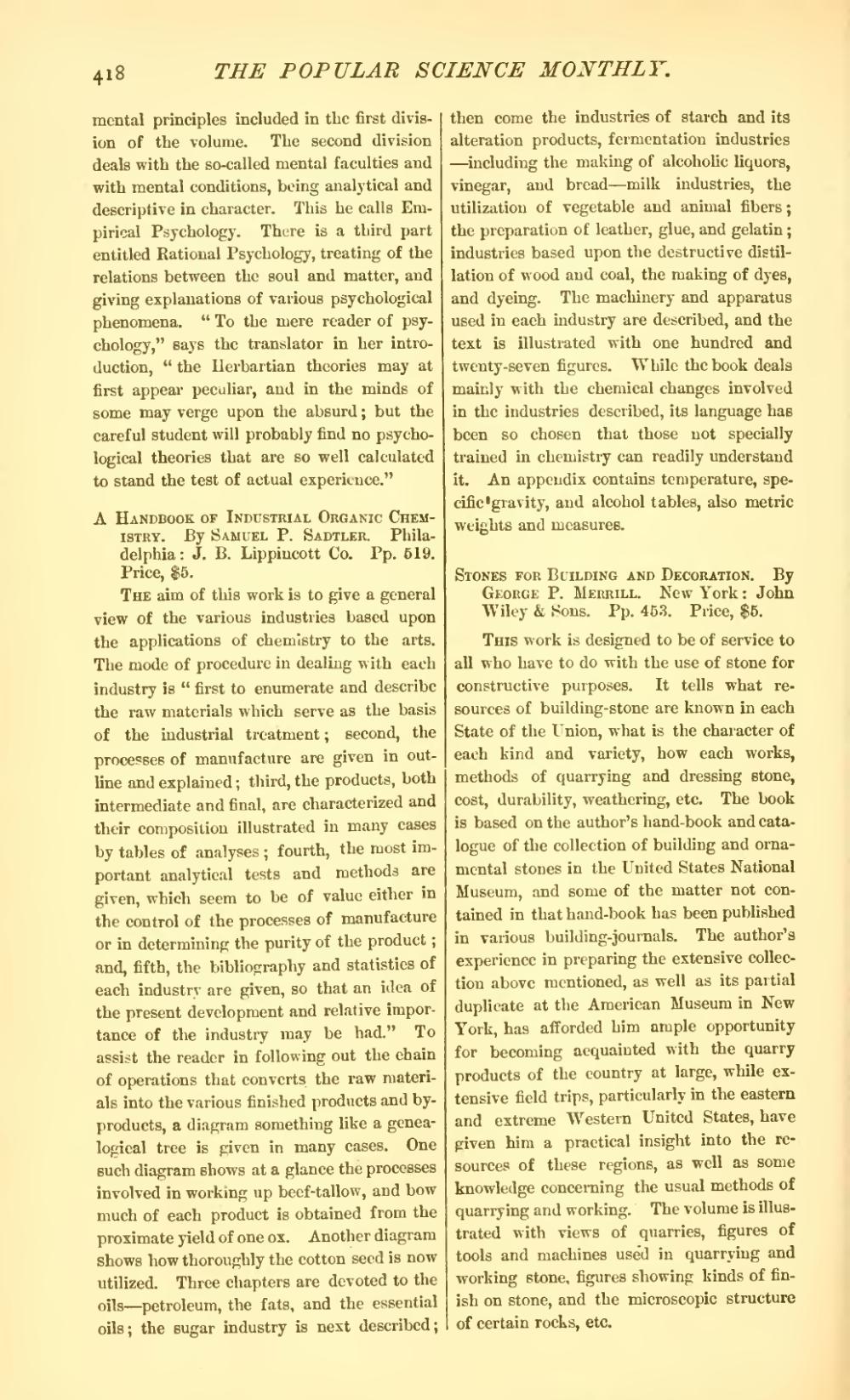mental principles included in the first division of the volume. The second division deals with the so-called mental faculties and with mental conditions, being analytical and descriptive in character. This he calls Empirical Psychology. There is a third part entitled Rational Psychology, treating of the relations between the soul and matter, and giving explanations of various psychological phenomena. "To the mere reader of psychology," says the translator in her introduction, "the Herbartian theories may at first appear peculiar, and in the minds of some may verge upon the absurd; but the careful student will probably find no psychological theories that are so well calculated to stand the test of actual experience."
A Handbook of Industrial Organic Chemistry. By Samuel P. Sadtler. Philadelphia: J. B. Lippincott Co. Pp. 619. Price, $5.
The aim of this work is to give a general view of the various industries based upon the applications of chemistry to the arts. The mode of procedure in dealing with each industry is "first to enumerate and describe the raw materials which serve as the basis of the industrial treatment; second, the processes of manufacture are given in outline and explained; third, the products, both intermediate and final, are characterized and their composition illustrated in many cases by tables of analyses; fourth, the most important analytical tests and methods are given, which seem to be of value either in the control of the processes of manufacture or in determining the purity of the product; and, fifth, the bibliography and statistics of each industry are given, so that an idea of the present development and relative importance of the industry may be had." To assist the reader in following out the chain of operations that converts the raw materials into the various finished products and byproducts, a diagram something like a genealogical tree is given in many cases. One such diagram shows at a glance the processes involved in working up beef-tallow, and how much of each product is obtained from the proximate yield of one ox. Another diagram shows how thoroughly the cotton seed is now utilized. Three chapters are devoted to the oils—petroleum, the fats, and the essential oils; the sugar industry is next described; then come the industries of starch and its alteration products, fermentation industries—including the making of alcoholic liquors, vinegar, and bread—milk industries, the utilization of vegetable and animal fibers; the preparation of leather, glue, and gelatin; industries based upon the destructive distillation of wood and coal, the making of dyes, and dyeing. The machinery and apparatus used in each industry are described, and the text is illustrated with one hundred and twenty-seven figures. While the book deals mainly with the chemical changes involved in the industries described, its language has been so chosen that those not specially trained in chemistry can readily understand it. An appendix contains temperature, specific gravity, and alcohol tables, also metric weights and measures.
Stones for Building and Decoration. By George P. Merrill. New York: John Wiley & Sons. Pp. 453. Price, $5.
This work is designed to be of service to all who have to do with the use of stone for constructive purposes. It tells what resources of building-stone are known in each State of the Union, what is the character of each kind and variety, how each works, methods of quarrying and dressing stone, cost, durability, weathering, etc. The book is based on the author's hand-book and catalogue of the collection of building and ornamental stones in the United States National Museum, and some of the matter not contained in that hand-book has been published in various building-journals. The author's experience in preparing the extensive collection above mentioned, as well as its partial duplicate at the American Museum in New York, has afforded him ample opportunity for becoming acquainted with the quarry products of the country at large, while extensive field trips, particularly in the eastern and extreme Western United States, have given him a practical insight into the resource? of these regions, as well as some knowledge concerning the usual methods of quarrying and working. The volume is illustrated with views of quarries, figures of tools and machines used in quarrying and working stone, figures showing kinds of finish on stone, and the microscopic structure of certain rocks, etc.

